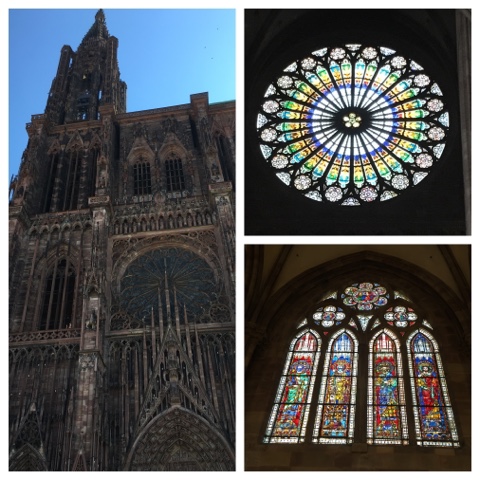The Alsace German French background is reflected in the homes. German timberframe homes were built between the 16th and 17th centuries. Each timber was numbered to allow them to be deconstructed, moved and rebuilt. The later change to the stone French style traded off mobility to leesen chance of fire.
Stork motifs can be found everywhere as can large white and black storks who tend to live atop homes and in trees of a particular neighborhood where they are fed by the community. Legend has it that if a sugar cube is placed on a windowsill a baby will soon appear. With a population of 480 thousand (52 thousand if which are medical and Pharma students), it would seem that the storks have been kept quite busy.
The cuisine options are many and all delicious. You can easily guess Steve was drawn to the menu on the left and Karen to the right, but there are no bad food choices here.
Notre Dame Cathedral of Strasbourg was built between the 13th and 15th centuries in the Gothic style. The exceptional original stained glass was removed during the World War for safe keeping and the reinserted, including the spectacular rose window that is similar to the one found in Paris. The pink sandstone structure requires a team of 50 to continuously repair this delicate structure.
The astronomical clock has not failed in hundreds of years. An example of exceptional engineering, it tracks time and days, making allowances for months of various lengths and leap year. About midway up, when the clock strikes reflecting another fifteen minutes has passed, a figure of either a baby, youth, soldier or elderly man passes by, indicating life's 4 phases. At 12:30 is when the real action happens, complete with all 12 apostles cross in front of Christ. The cathedral closes from 11:30 to 12:35, so if you want to see how a click originally installed in the mid 1300's and last updated in the mid 1800's performs this remarkable feat, then I suggest you get there early!





No comments:
Post a Comment